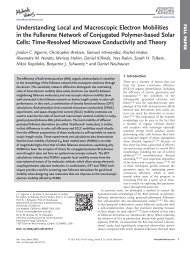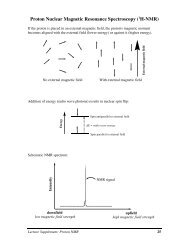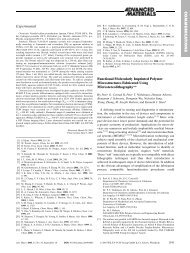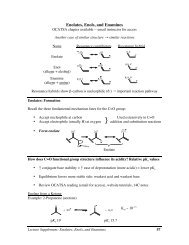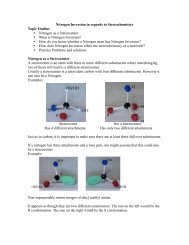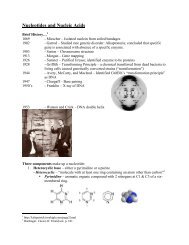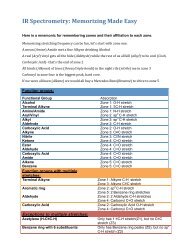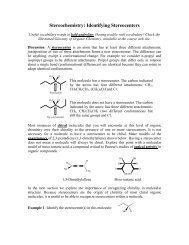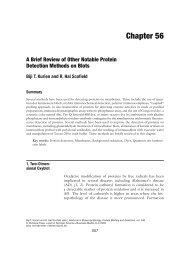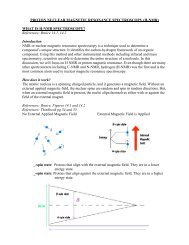Exam 1 - UCLA Chemistry and Biochemistry
Exam 1 - UCLA Chemistry and Biochemistry
Exam 1 - UCLA Chemistry and Biochemistry
You also want an ePaper? Increase the reach of your titles
YUMPU automatically turns print PDFs into web optimized ePapers that Google loves.
<strong>Chemistry</strong> 14C Lecture 1 Spring 2013 <strong>Exam</strong> 1 Page 1<br />
OK to use "Ph" anywhere on this exam where appropriate.<br />
Exceeding the specified word limit on an answer will result in a point deduction for that answer.<br />
Terfenadine <strong>and</strong> fexofenadine are antihistamines. Terfenadine appeared on the market first, but was superseded by<br />
fexofenadine because the latter has a lower risk of causing cardiac arrthymia. Terfenadine is a prodrug, meaning that<br />
terfenadine is not active until metabolized in the body, in this case, into fexofenadine. The structures of these<br />
molecules can be found on the exam information page (the last exam page). The questions on this exam refer to<br />
terfenadine <strong>and</strong> fexofenadine.<br />
1. (3) Write the molecular formula (i.e., C 6 H 60 ) for fexofenadine.<br />
2. (2) Write the name of the functional group formed when terfenadine is metabolized into fexofenadine.<br />
3. (24) Write a number in each blank.<br />
(a) Of the oxygen atoms in fexofenadine _______ are sp 3 , ________ <strong>and</strong> sp 2 , <strong>and</strong> ________ are sp.<br />
(b) Fexofenadine has ________ atoms with p orbitals <strong>and</strong> ________ conjugated atoms.<br />
(c) Fexofenadine has ________ lone pairs in total. Of these lone pairs _________ are delocalized by resonance.<br />
(d) Of the sp 3 stereocenters in fexofenadine, _____ have an R configuration <strong>and</strong> _____ have an S configuration.<br />
(e) The fexofenadine structure shown on the information page has ________ enantiomers <strong>and</strong> _________<br />
diastereomers. There are ______ fexofendine stereoisomers that are also meso compounds.<br />
4. (6) Fexofenadine is... Circle the one best answer in each set.<br />
(a) Chiral Achiral Both Neither Cannot determine from given information<br />
(b) Optically active Optically inactive Both Neither Cannot determine from given information<br />
(c) Dextrorotatory Levorotatory Both Neither Cannot determine from given information<br />
5. (2) Terfenadine may cause cardiac arrhythmia (abnormal electrical activity in the heart, often causing irregular<br />
heartbeat). What can we conclude about the possible drug effects of terfenadine's enantiomer? Circle all that<br />
apply.<br />
(a) Causes stronger cardiac arrhythmia.<br />
(b) Causes weaker cardiac arrhythmia.<br />
(c) Causes cardiac arrthymia, but to what extent, we cannot predict.<br />
(d) The enantiomer causes a much steadier heartbeat than is normally present.<br />
(e) It cures cardiac arrhythmia, so terfenadine should be sold as a racemic mixture.<br />
(f) None of these conclusions are valid.<br />
Page 1 score =
<strong>Chemistry</strong> 14C Lecture 1 Spring 2013 <strong>Exam</strong> 1 Page 2<br />
Levamisole is an anthelminthic (i.e., it is used to treat worm infestations in humans<br />
<strong>and</strong> animals). The molecule also causes some neurological stimulation, which<br />
probably explains why ~80% of cocaine seized by the FDA in recent years was<br />
found to be have been "cut" (i.e., mixed) with detectable levels of levamisole.<br />
Cocaine cut with levamisole appears to be more toxic than cocaine itself.<br />
N<br />
Levamisole<br />
N<br />
S<br />
6. (8) In each box below, draw one additional levamisole resonance contributor. Make your contributors as<br />
significant as possible. Include all lone pairs <strong>and</strong> formal charges for contributors B <strong>and</strong> C.<br />
N<br />
N<br />
S<br />
Contributor A Contributor B Contributor C<br />
7. (10) Now let's evaluate the relative significance of the contributors you drew in question 6. In each case, circle<br />
"more significant than", "less significant than", or "equally significant as" as appropriate. If you've circled<br />
"equally significant as" you are done with this part. If you've circled "more significant than" or "less significant<br />
than" complete the statement by adding no more than ten words in each of the open spaces.<br />
(a) Contributor B is more significant than / equally significant as / less significant than contributor A because<br />
contributor B...<br />
...whereas contributor A...<br />
(b) Contributor C is more significant than / equally significant as / less significant than contributor A because<br />
contributor C...<br />
...whereas contributor A...<br />
8. (4) Complete this drawing of the levamisole resonance hybrid by<br />
adding all missing partial pi bonds. Use **all** significant<br />
contributors to construct this hybrid. Do not include any δ + or δ -<br />
charges to this drawing. Practice your answer on the back of an<br />
exam page before you draw your final answer here.<br />
N<br />
N<br />
S<br />
9. (2) For the resonance hybrid of question 8, which elements have at least one atom that has a δ + charge? Circle<br />
all that apply:<br />
Carbon Nitrogen Sulfur Hydrogen None of these<br />
Page 2 score =
<strong>Chemistry</strong> 14C Lecture 1 Spring 2013 <strong>Exam</strong> 1 Page 3<br />
10. (14) In a (fictitious) drug metabolism study, it was discovered that in the body levamisole is in equilibrium with<br />
molecule D:<br />
N<br />
K eq = ?<br />
N<br />
N<br />
S<br />
N<br />
S<br />
Levamisole<br />
Molecule D<br />
Let's see if we can predict the position of this equilibrium. The following questions will guide us. Write a<br />
number in each blank, or circle 'yes' or 'no', as appropriate.<br />
(a) Molecule D has _________ atoms with p orbitals.<br />
(b) Do all the atoms which host these p orbitals lie in the same plane? Yes<br />
No<br />
(c) Does molecule D have a closed loop of p orbitals? Yes<br />
No<br />
(d) Molecule D has ________ pi electrons.<br />
(e) Does molecule D obey Hückel's rule? Yes<br />
No<br />
(f) Is molecule D aromatic? Yes<br />
No<br />
(g) So what do we conclude about K eq ? Circle one:<br />
(i) The equilibrium favors levamisole (K eq < 1)<br />
(ii) The equilibrium does not strongly favor either side (K eq ~ 1)<br />
(iii) The equilibrium favors molecule D (K eq > 1)<br />
11. (4) Levamisole is pale yellow. Molecule D is not the exact same color as levamisole.<br />
(a) Circle the molecule with the smallest HOMO-LUMO gap:<br />
Levamisole Molecule D About equal No way to determine or approximate from given information<br />
(b) Circle the best guess for the color of molecule D:<br />
Colorless Also yellow, but a darker shade than levamisole Orange<br />
Reaction of levamisole with HCl produces a hydrochloride salt, marketed under the trade name of Ergamisol, an<br />
immunomodulator <strong>and</strong> treatment for parasites. Cation E <strong>and</strong> cation F are not produced in this process.<br />
N<br />
H<br />
N<br />
Ph<br />
HCl<br />
N<br />
N S Ph<br />
N S<br />
N<br />
H<br />
N S<br />
Levamisol Ergamisol Cation E Cation F<br />
12. (2) What is the relationship between Ergamisol <strong>and</strong> cation E? Circle all that apply:<br />
Constitutional isomers Conformational isomers Configurational isomers Stereoisomers<br />
Enantiomers Diastereomers Meso compounds None of these<br />
N<br />
S<br />
Page 3 score =
<strong>Chemistry</strong> 14C Lecture 1 Spring 2013 <strong>Exam</strong> 1 Page 4<br />
13. (5) Let's figure out why reaction of levamisole with HCl forms Ergamisol, <strong>and</strong> not cation E or cation F. In each<br />
case below, circle one or more reasons that explain why Ergamisol is formed instead of the cation listed.<br />
(a) Ergomisol is formed instead of cation E due to changes in (circle one or more):<br />
Resonance Conjugation Aromaticity Stereochemistry Color Formal charge Strain<br />
(b) Ergomisol is formed instead of cation F due to changes in (circle one or more):<br />
Resonance Conjugation Aromaticity Stereochemistry Color Formal charge Strain<br />
Reaction of D-glucose with NaBH 4 produces sorbitol, used as a substitute for sucrose (table sugar). Sorbitol is also<br />
found in apples, pears, peaches, <strong>and</strong> prunes. When metabolized, sorbitol is first converted into fructose.<br />
D-glucose<br />
NaBH 4<br />
H 2 O HO<br />
OH OH Question 15 OH Metabolism Fructose<br />
OH<br />
OH<br />
Sorbitol<br />
14. (3) Circle all of ways in which correctly complete this statement: The structures of sorbitol <strong>and</strong> sucrose differ in<br />
the presence or absence of...<br />
...an acetal ...an anomeric carbon ...at least four stereocenters ...a pyranose None of these are correct<br />
15. (5) Metabolism converts sorbitol into fructose (a ketohexose) by changing the alcohol stereocenter indicated<br />
above into a carbonyl group. No other changes occur. Using this information, complete this drawing of fructose.<br />
C<br />
O<br />
C<br />
C<br />
C<br />
C<br />
16. (2) The fructose produced by enzymatic oxidation of sorbitol is (circle one):<br />
D-fructose L-fructose Neither of these Cannot determine from the given information<br />
17. (4) Draw β-D-glucopyranose. Neatness counts!<br />
Page 4 score =



